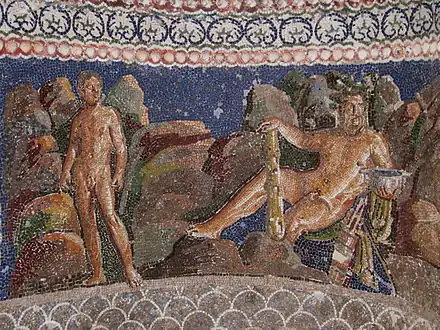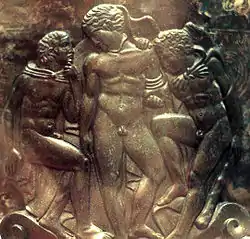Iolaus
In Greek mythology, Iolaus (/aɪˈoʊlaʊs/; Ancient Greek: Ἰόλαος Iólaos) was a Theban divine hero, son of Iphicles and Automedusa.

He was famed for being Heracles' nephew and for helping with some of his Labors, and also for being one of the Argonauts. Through his daughter Leipephilene, he was considered to have fathered the mythic and historic line of the kings of Corinth, ending with Telestes.
A genus of Lycaenid butterfly has been named after him.
An exoplanet around star HAT-P-42 (now named Lerna) is named after him.[1]
Relationship with Heracles
As a son of Iphicles, Iolaus was a nephew of Heracles. He often acted as Heracles' charioteer and companion. Plutarch claimed that he was Heracles' lover, and that the shrine to him in Thebes was a place where male couples worshiped and made vows.[2]
The Theban gymnasium was also named after him, and the Iolaia or Iolaea (Greek: Ιολάεια), an athletic festival consisting of gymnastic and equestrian events, was held yearly in Thebes in his honor.[3] The victors at the Iolaea were crowned with garlands of myrtle.[4]
Iolaus provided essential help to Heracles in his battle against the Hydra, his second labor. Seeing that Heracles was being overwhelmed by the multi-headed monster (the Lernaean Hydra), who grew two heads in place of each one cut off, Iolaus helped by cauterizing each neck as Heracles beheaded it.
Heracles gave his wife, Megara, age thirty three, to Iolaus, then only sixteen years old[5] – ostensibly because the sight of her reminded him of his murder of their three children. They had a daughter, Leipephilene. He was one of the Heraclidae.[6]
Upon Heracles' death, Iolaus lit the funeral pyre. However, according to some mythographers, this was Philoctetes instead. In Sophocles' Philoctetes, Philoctetes was given Heracles' bow and arrow as reward for lighting the funeral pyre.[7] In other versions, it is Poeas.
According to Diodorus Siculus, Iolaus was sent by Heracles to Sardinia, together with nine of the sons that he had with the fifty daughters of Thespius (the Thespiades), to colonize the island, giving rise to the Iolei people .[8]
Iolaus and the Thespians were buried in Sardinia.
Aristotle said that Sardinia had practiced the rite of incubation, which is the liberation ritual of the people who were affected by nightmares and obsessions. These rituals included that the persons suffering from nightmares should sleep next to the tombs of heroes.[9]
Simplicius of Cilicia adds, in the eight books of the Commentaries Aristotle, that "the places where they were deposited and preserved corpses of the nine heroes that Heracles got from the Thespians and who came to Sardinia with the colony of Iolaus, became the famous oracles."[10]
Solinus says: "The Iolians, so named by him (Iolaus), added a temple to his tomb, because he had freed Sardinia from many ills".[11]
Notes
- "Approved names". NameExoworlds. Retrieved 2019-12-17.
- Crompton, Louis, Homosexuality and Civilization, Cambridge, MA: Harvard University Press, 2003, p. 123.
- Pindar, Olympian Ode VIII, 84
- Pindar, Isthmian Ode IV.
- Plutarch, Moralia "The Dialogue on Love / Erotikos / Amatoria", Loeb, V. XII, p.339
- Ovid, Metamorphoses IX, 394.
- Sophocles Philoctetes
- Diodorus Siculus, book IV, 29–30.
- Aristotle, Physics, IV.
- Simplicius, book IV.
- Solinus, I-16: Iolenses ab eo dicti sepulcro eius templum addiderunt quod ... Malis plurimis Sardiniam liberasset.
External links
 Media related to Iolaus at Wikimedia Commons
Media related to Iolaus at Wikimedia Commons

